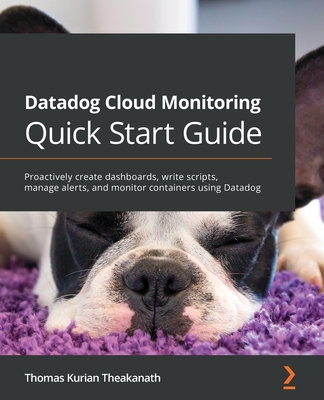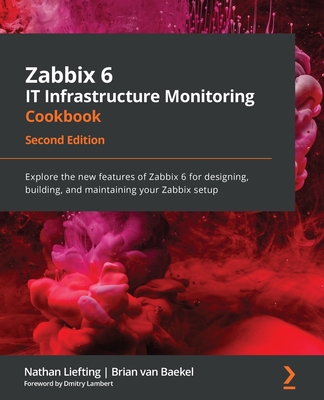Datadog Cloud Monitoring Quick Start Guide: Proactively create dashboards, write scripts, manage alerts, and monitor containers using Datadog
暫譯: Datadog 雲端監控快速入門指南:主動創建儀表板、編寫腳本、管理警報及使用 Datadog 監控容器
Thomas Kurian Theakanath
- 出版商: Packt Publishing
- 出版日期: 2021-06-25
- 售價: $1,650
- 貴賓價: 9.5 折 $1,568
- 語言: 英文
- 頁數: 318
- 裝訂: Paperback
- ISBN: 1800568738
- ISBN-13: 9781800568730
-
相關分類:
DevOps
海外代購書籍(需單獨結帳)
相關主題
商品描述
A comprehensive guide to rolling out Datadog to monitor infrastructure and applications running in both cloud and datacenter environments
Key Features
- Learn Datadog to proactively monitor your infrastructure and cloud services
- Use Datadog as a platform for aggregating monitoring efforts in your organization
- Leverage Datadog's alerting service to implement on-call and site reliability engineering (SRE) processes
Book Description
Datadog is an essential cloud monitoring and operational analytics tool which enables the monitoring of servers, virtual machines, containers, databases, third-party tools, and application services. IT and DevOps teams can easily leverage Datadog to monitor infrastructure and cloud services, and this book will show you how.
The book starts by describing basic monitoring concepts and types of monitoring that are rolled out in a large-scale IT production engineering environment. Moving on, the book covers how standard monitoring features are implemented on the Datadog platform and how they can be rolled out in a real-world production environment. As you advance, you'll discover how Datadog is integrated with popular software components that are used to build cloud platforms. The book also provides details on how to use monitoring standards such as Java Management Extensions (JMX) and StatsD to extend the Datadog platform. Finally, you'll get to grips with monitoring fundamentals, learn how monitoring can be rolled out using Datadog proactively, and find out how to extend and customize the Datadog platform.
By the end of this Datadog book, you will have gained the skills needed to monitor your cloud infrastructure and the software applications running on it using Datadog.
What you will learn
- Understand monitoring fundamentals, including metrics, monitors, alerts, and thresholds
- Implement core monitoring requirements using Datadog features
- Explore Datadog's integration with cloud platforms and tools
- Extend Datadog using custom scripting and standards such as JMX and StatsD
- Discover how proactive monitoring can be rolled out using various Datadog features
- Understand how Datadog can be used to monitor microservices in both Docker and Kubernetes environments
- Get to grips with advanced Datadog features such as APM and Security Monitoring
Who this book is for
This book is for DevOps engineers, site reliability engineers (SREs), IT Production engineers, software developers and architects, cloud engineers, system administrators, and anyone looking to monitor and visualize their infrastructure and applications with Datadog. Basic working knowledge of cloud and infrastructure is useful. Working experience of Linux distribution and some scripting knowledge is required to fully take advantage of the material provided in the book.
商品描述(中文翻譯)
全面指南:如何部署 Datadog 以監控運行於雲端和數據中心環境中的基礎設施和應用程式
主要特點
- 學習使用 Datadog 主動監控您的基礎設施和雲端服務
- 將 Datadog 作為聚合您組織內監控工作的平臺
- 利用 Datadog 的警報服務實施值班和網站可靠性工程 (SRE) 流程
書籍描述
Datadog 是一個重要的雲端監控和運營分析工具,能夠監控伺服器、虛擬機、容器、數據庫、第三方工具和應用服務。IT 和 DevOps 團隊可以輕鬆利用 Datadog 來監控基礎設施和雲端服務,本書將向您展示如何做到這一點。
本書首先描述了在大規模 IT 生產工程環境中推出的基本監控概念和監控類型。接著,本書涵蓋了如何在 Datadog 平臺上實施標準監控功能,以及如何在實際生產環境中推出這些功能。隨著進一步的學習,您將發現 Datadog 如何與用於構建雲端平臺的流行軟體組件集成。本書還提供了如何使用監控標準,如 Java Management Extensions (JMX) 和 StatsD,來擴展 Datadog 平臺的詳細資訊。最後,您將掌握監控的基本原則,學習如何主動使用 Datadog 進行監控,並了解如何擴展和自定義 Datadog 平臺。
在閱讀完這本 Datadog 書籍後,您將獲得使用 Datadog 監控您的雲端基礎設施及其上運行的軟體應用程式所需的技能。
您將學到什麼
- 理解監控的基本原則,包括指標、監控器、警報和閾值
- 使用 Datadog 功能實施核心監控需求
- 探索 Datadog 與雲端平臺和工具的集成
- 使用自定義腳本和標準(如 JMX 和 StatsD)擴展 Datadog
- 發現如何使用各種 Datadog 功能主動推出監控
- 理解如何在 Docker 和 Kubernetes 環境中使用 Datadog 監控微服務
- 掌握 Datadog 的高級功能,如 APM 和安全監控
本書適合誰
本書適合 DevOps 工程師、網站可靠性工程師 (SRE)、IT 生產工程師、軟體開發人員和架構師、雲端工程師、系統管理員,以及任何希望使用 Datadog 監控和可視化其基礎設施和應用程式的人士。具備基本的雲端和基礎設施工作知識將會有所幫助。為了充分利用本書提供的材料,需具備 Linux 發行版的工作經驗和一些腳本知識。
作者簡介
Thomas has over 15 years of experience in software development and operations engineering, and currently focussed on Cloud Engineering and DevOps. He has architected, developed, and rolled out automation tools and processes at startups and large companies. He led and mentored engineering teams to successful completion of large DevOps and monitoring projects. He contributes regularly to tech blogs on latest trends and best practices on his areas of expertise.
作者簡介(中文翻譯)
Thomas 擁有超過 15 年的軟體開發和運營工程經驗,目前專注於雲端工程和 DevOps。他在初創公司和大型企業中設計、開發並推出自動化工具和流程。他領導並指導工程團隊成功完成大型 DevOps 和監控專案。他定期為技術部落格撰寫有關其專業領域的最新趨勢和最佳實踐的文章。
目錄大綱
Table of Contents
- Introduction to Monitoring
- Datadog Agent
- Datadog Dashboard
- Account Management
- Metrics, Events and Tags
- Monitoring Infrastructure
- Monitors and Alerts
- Integrating with Platform Components
- Using Datadog HTTP API
- Working with Monitoring Standards
- Integrating with Datadog
- Advanced Container Monitoring
- Log Management using Datadog
- Miscellaneous Monitoring Features
目錄大綱(中文翻譯)
Table of Contents
- Introduction to Monitoring
- Datadog Agent
- Datadog Dashboard
- Account Management
- Metrics, Events and Tags
- Monitoring Infrastructure
- Monitors and Alerts
- Integrating with Platform Components
- Using Datadog HTTP API
- Working with Monitoring Standards
- Integrating with Datadog
- Advanced Container Monitoring
- Log Management using Datadog
- Miscellaneous Monitoring Features











